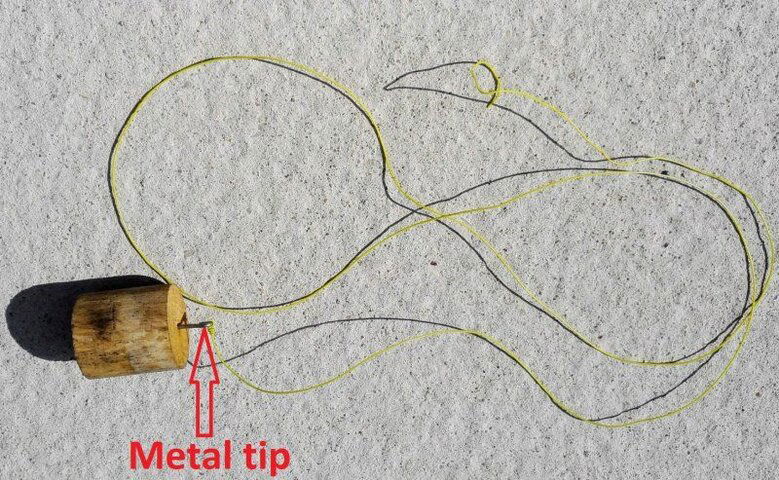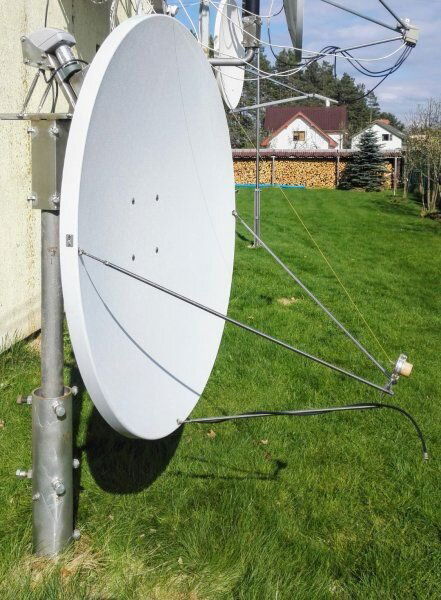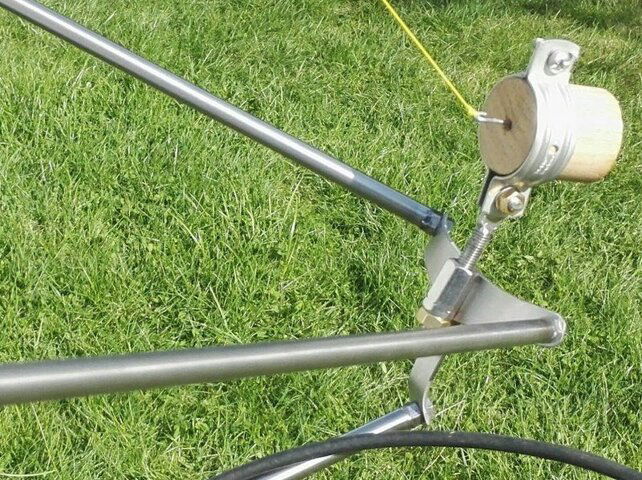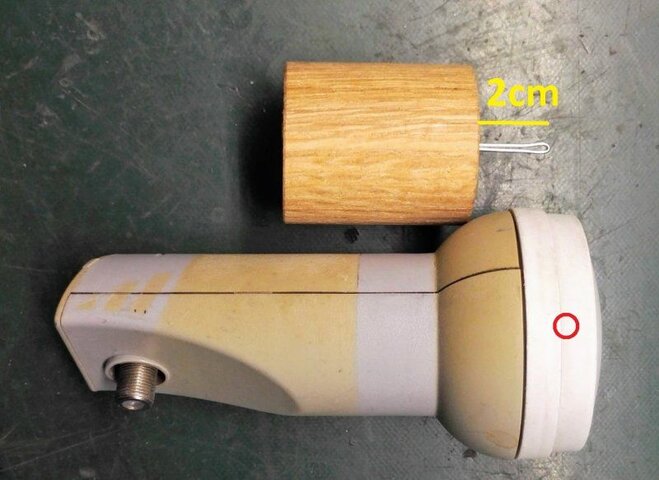Edge to edge is not important at all, you need to know the size of the working area. And you also need to check the geometry of the dish by performing the string test. And third thing..... what is the leaning angle of the face of the dish when you have it pointed to satellite?Edge to Edge
2.4 meter Prime Focus high quality dish performs worse than a 90 cm Chinese offset dish on Ku
- Thread starter enb141
- Start date
- Latest activity Latest activity:
- Replies 44
- Views 8K
You are using an out of date browser. It may not display this or other websites correctly.
You should upgrade or use an alternative browser.
You should upgrade or use an alternative browser.
- Status
- Please reply by conversation.
Edge to edge is not important at all, you need to know the size of the working area. And you also need to check the geometry of the dish by performing the string test. And third thing..... what is the leaning angle of the face of the dish when you have it pointed to satellite?
When I measured the blue line, I did it only taking in count the inner part of the dish
What's the string test?
how to measure the leaning angle of the face of the dish?
yes we all agree that the dish needs a prime-focus type feedhorn, the suggestion to use the other LNBF was just to get a quick diagnostic by eliminating one variable.Hi, thanks for the response, yes, I'm aware that prime focus dishes need prime focus LNBs that's why I was previously using an invacom prime focus LNB + C120 feedhorn shown in the pictures. Then the other guy, Brct203, suggested to try another LNB, right now I only have offset LNBs to test so I did the test but the results were pretty much the same in comparison with the invacom + feedhorn lnb.
for the offset LNB I'm using this LNB holder:

this is the dish I'm using and according to the manual the f/d is 0.37
https://www.sateng.com/downloads/1252-53.pdf
yes we all agree that the dish needs a prime-focus type feedhorn, the suggestion to use the other LNBF was just to get a quick diagnostic by eliminating one variable.
I did and I got about the same results so now I have to check for another LNB that designed for prime focus dishes for real, what I still don't know is why invacom claims their LNB is designed for prime focus dishes which is clearly false
https://www.gionlineshop.com/Downloads/ADJUSTfeedHORN.pdf
Sorry. I highly disagree with your assertion that Invacom claims are false!
The Invacom feedhorn IS designed and adjustable for the lower FD ratio prime focus reflectors (a feedhorn is not a LNB). It works exactly as described when mounted properly on a low FD ratio reflector that is a good parabola that is appropriate for the 10.7-12.75 frequency range, not warped and the feed is placed in the correct convergence and focal point. In my usage and testing, the Invacom adjustable scalar/feedhorn has always out performed a standard fixed scalar / high FD type LNBFs by 20% and more on an proper prime focus reflector.
Obviously, in reading this thread, the feedhorn was simply mounted without calculating the FD and FL or optimizing the scalar placement or FD setting. Maybe you are expecting a miracle to happen without calculating and optimizing the feed? It is easy to blame a quality product for our own misuse and misunderstandings....
1. A string test is performed by placing 3 or more strings across the face of the reflector (edge to edge) and several angles around the dish. Observe where the strings intersect. Do the strings lightly touch or is there a gap between the strings? Gaps indicate that the reflector parabola is not accurate and is warped. This causes reflected signals to be directed away from the feedhorn opening and lost. A small gap may be acceptable (but makes the dish inefficient). A large gap means much of the reflected satellite signals are not entering the feedhorn resulting in poor performance and efficiency losses.
2. The dish angle is measured by placing a straight edge on the 12 / 6 o'clock positions on the reflector edge. If the angle does not equal the calculated angle for the received satellite, the feedhorn is not centered on the reflector and some signal is being lost because it is not focussing into the feedhorn.
The Invacom feedhorn IS designed and adjustable for the lower FD ratio prime focus reflectors (a feedhorn is not a LNB). It works exactly as described when mounted properly on a low FD ratio reflector that is a good parabola that is appropriate for the 10.7-12.75 frequency range, not warped and the feed is placed in the correct convergence and focal point. In my usage and testing, the Invacom adjustable scalar/feedhorn has always out performed a standard fixed scalar / high FD type LNBFs by 20% and more on an proper prime focus reflector.
Obviously, in reading this thread, the feedhorn was simply mounted without calculating the FD and FL or optimizing the scalar placement or FD setting. Maybe you are expecting a miracle to happen without calculating and optimizing the feed? It is easy to blame a quality product for our own misuse and misunderstandings....
1. A string test is performed by placing 3 or more strings across the face of the reflector (edge to edge) and several angles around the dish. Observe where the strings intersect. Do the strings lightly touch or is there a gap between the strings? Gaps indicate that the reflector parabola is not accurate and is warped. This causes reflected signals to be directed away from the feedhorn opening and lost. A small gap may be acceptable (but makes the dish inefficient). A large gap means much of the reflected satellite signals are not entering the feedhorn resulting in poor performance and efficiency losses.
2. The dish angle is measured by placing a straight edge on the 12 / 6 o'clock positions on the reflector edge. If the angle does not equal the calculated angle for the received satellite, the feedhorn is not centered on the reflector and some signal is being lost because it is not focussing into the feedhorn.
I did and I got about the same results so now I have to check for another LNB that designed for prime focus dishes for real, what I still don't know is why invacom claims their LNB is designed for prime focus dishes which is clearly false
https://www.gionlineshop.com/Downloads/ADJUSTfeedHORN.pdf
I'm not sure that I understand why you're saying it's not made for Prime Focus dishes. In my opinion the fact that the other LNBF gave you similar results tends to mean that there might be something wrong with the dish, either a geometry problem (but it seems that so far that looks fine) or maybe that it's just not so good at Ku - which is in contradiction with the claims by the manufacturer. I think that at this point none of the tests have yielded a clear conclusion.
You were asking earlier about the string test. The idea is to make sure that the disk is not warped. The way to do this is to take 2 strings, and something to attach the strings to the edges of the dish (binder clips might be a good option), and set both strings across the dish, perpendicular to each other, for example one vertical and one horizontal. The should barely touch where they intersect (the should touch but not push each other more than by the thickness of the string, so at most a couple of mm). if they don't touch or one deviates the other by more than 2-3 mm, then the dish is warped. That could be caused by a less than perfect assembly of the dish, or by accident (especially on metal dishes), or by mediocre manufacturing (unlikely on a Prodelin)
Sorry. I highly disagree with your assertion that Invacom claims are false!
The Invacom feedhorn IS designed and adjustable for the lower FD ratio prime focus reflectors (a feedhorn is not a LNB). It works exactly as described when mounted properly on a low FD ratio reflector that is a good parabola that is appropriate for the 10.7-12.75 frequency range, not warped and the feed is placed in the correct convergence and focal point. In my usage and testing, the Invacom adjustable scalar/feedhorn has always out performed a standard fixed scalar / high FD type LNBFs by 20% and more on an proper prime focus reflector.
Obviously, in reading this thread, the feedhorn was simply mounted without calculating the FD and FL or optimizing the scalar placement or FD setting. Maybe you are expecting a miracle to happen without calculating and optimizing the feed? It is easy to blame a quality product for our own misuse and misunderstandings....
1. A string test is performed by placing 3 or more strings across the face of the reflector (edge to edge) and several angles around the dish. Observe where the strings intersect. Do the strings lightly touch or is there a gap between the strings? Gaps indicate that the reflector parabola is not accurate and is warped. This causes reflected signals to be directed away from the feedhorn opening and lost. A small gap may be acceptable (but makes the dish inefficient). A large gap means much of the reflected satellite signals are not entering the feedhorn resulting in poor performance and efficiency losses.
2. The dish angle is measured by placing a straight edge on the 12 / 6 o'clock positions on the reflector edge. If the angle does not equal the calculated angle for the received satellite, the feedhorn is not centered on the reflector and some signal is being lost because it is not focussing into the feedhorn.
About the feedhorn + the LNB invacom, I did lots of tests with different positioning of the feedhorn threading (from 0 to the LNB to 0 mm to the dish). In pretty much all tests it gave me the same results, the only way I was able to get a little bit better results was to putting further away the LNB+feedhorn to the dish, in this case scenario I was getting better results but still worse than a 90 cm offset dish with an offset LNB. So to me that LNB is not working as it should for prime focus dishes, at least the one I have.
Thanks for explaining the string test, I'm gonna check that tomorrow.
I'm also going to check the elevation to see if matches the calculated one.
Changing the threaded position is only changing the FD ratio adjusting the amount of reflector illumination or over illumination and side lobe null.
Proper placement and optimization is a result of the combination of both setting the FD ratio (threaded adjustment) and placing the feedhorn opening at the correct FL (distance) from the reflector.
Calculate the correct FD ratio and FL using the reflector diameter and depth. For a description of proper feedhorn install and optimization with calculations, see this guide distributed with Titanium Satellite LNBFs: www.titaniumsatellite.com/downloads/Guides/LNBF%20Install%20Guide.pdf
Proper placement and optimization is a result of the combination of both setting the FD ratio (threaded adjustment) and placing the feedhorn opening at the correct FL (distance) from the reflector.
Calculate the correct FD ratio and FL using the reflector diameter and depth. For a description of proper feedhorn install and optimization with calculations, see this guide distributed with Titanium Satellite LNBFs: www.titaniumsatellite.com/downloads/Guides/LNBF%20Install%20Guide.pdf
Last edited:
100% agree. I also have an Invacom for my prime focus Birdview 8.5' dish and it works very well on KU band. The dish has an F/D ratio around 0.4....
The Invacom feedhorn IS designed and adjustable for the lower FD ratio prime focus reflectors (a feedhorn is not a LNB). It works exactly as described when mounted properly on a low FD ratio reflector that is a good parabola that is appropriate for the 10.7-12.75 frequency range, not warped and the feed is placed in the correct convergence and focal point. In my usage and testing, the Invacom adjustable scalar/feedhorn has always out performed a standard fixed scalar / high FD type LNBFs by 20% and more on an proper prime focus reflector.....
As mentioned earlier, KU band requires far more surface accuracy than C-Band. In general, the surface inaccuracies should not exceed about 1/6th of a wavelength at the operating frequency. At 12 GHz, the wavelength is 2.5 cm, so the dish has to be accurate to within 0.4 cm (4 mm). Significant deviation from that results in parts of the dish canceling out the signal from other parts of the dish.
As for the placement, I found that the distance from the dish to the feedhorn was critical. It had to be within a few millimeters and it took a lot of trial and error to find the optimum distance.
Thaynks for the advice N6BY and Titanium, after doing the string test, the dish seems to be flawless, doesn't seems to be a noticeable gap between the strings, so now back to do some tests about what should be the exact position of the focal point, but I'm still wondering why the performance is so bad, I mean even with bad positioning of the focal point the reception should be way better than a 90 cm offset dish, just my two cents.
Another question
Do the focal point distance should be measured from the end of the feedhorn or from where exactly?
Another question
Do the focal point distance should be measured from the end of the feedhorn or from where exactly?
Personally i would start again, first job would be to get the dish on the correct king-post and secured before it fly's off, then make sure your pole cap is plumb then get your angles correct using a digital inclinometer and don't forget to make sure LNB skew is correct and try again.
After doing more tests about putting the LNB lower or higher distances from the dish-feedhorn and I got better results with the offset Ku LNB than the Invacom + feedhorn.
With the offset I got -44db.
With the invacom + feedhorn I got -51db.
With the Chinese 90 cm metal dish offset dish I got -35db.
So I think the invacom is broken because I don't know why it is performing so bad with this antenna.
With the offset I got -44db.
With the invacom + feedhorn I got -51db.
With the Chinese 90 cm metal dish offset dish I got -35db.
So I think the invacom is broken because I don't know why it is performing so bad with this antenna.
Using the formulas for feed and scalar placement, what are the calculations for the FD and FL for your dish?
Did you verify centering by measuring the edge to the center of the feedhorn throat in 3 or 4 points around the reflector to verify the feed is perfectly centered?
Did you measure the vertical elevation angle from the 12 o'clock to the 6 o'clock positions to verify that it matches the calculated satellite elevation angle for your location?
Did you use a 90 degree builder square or a laser level to verify the scalar and/or feed is parallel and aimed to the exact center of the reflector?
If your performance finding is different than experienced hobbyists have found for the past 13 years, where might you think that the problem is?
Did you verify centering by measuring the edge to the center of the feedhorn throat in 3 or 4 points around the reflector to verify the feed is perfectly centered?
Did you measure the vertical elevation angle from the 12 o'clock to the 6 o'clock positions to verify that it matches the calculated satellite elevation angle for your location?
Did you use a 90 degree builder square or a laser level to verify the scalar and/or feed is parallel and aimed to the exact center of the reflector?
If your performance finding is different than experienced hobbyists have found for the past 13 years, where might you think that the problem is?

I tried different "angles" of the LNB, in other words I moved slightly and tried to match the distance to the center of the dish by "eye", also with a caliper but I think I'm gonna need a laser device to measure the distances, I was using a flexometer but is soo difficult to do measurements with that thing so I'm gonna buy a laser device for doing the right measurements.
I adjusted the scalar but I'm not sure if is from outside or from the inside that it should be measured
Thanks by your tips Titanium, next steps will be angles and laser measured distances
I adjusted the scalar but I'm not sure if is from outside or from the inside that it should be measured
Thanks by your tips Titanium, next steps will be angles and laser measured distances
To measure distances from Phase center of the LNB to different parts of the antenna you can make very simple but useful device, It is 40mm in diameter and has metal tip which represents the position of the Phase center. To the end of that metal there is piece of thread of wire tightened. So, you place the wooden part instead of your LNB and measure distances to the edges of the dish and also to the very center of the dish. Simple as that 
Add more pictures: This is how it works on smaller offset dish. No difference on bigger PFA.


Add more pictures: This is how it works on smaller offset dish. No difference on bigger PFA.


Cool idea, but what should be the length of the metal part, does it matter or doesn't?
That's gonna help to measure the distance from the center of the LNB to the edges of the dish and it should be the same distance in the whole dish (prime focus) right?
That's gonna help to measure the distance from the center of the LNB to the edges of the dish and it should be the same distance in the whole dish (prime focus) right?
I make metal part 20mm, but then you also can move the wooden part inside the holder. How to place the wooden part..... depend on the LNB you use. For example this LNB has Phase center somewhere inside it, approximately where I made red circle. Wooden part must be made out of oak  just kidding.... any type ow wood, plastic or any other material.
just kidding.... any type ow wood, plastic or any other material.
You are right for PFA all distances from the tip of metal to any side should be exactly the same.
 just kidding.... any type ow wood, plastic or any other material.
just kidding.... any type ow wood, plastic or any other material. You are right for PFA all distances from the tip of metal to any side should be exactly the same.

Hi guys it's been a few days and finally the bad weather got better so I was able to test a few toys that just came to my door.

I bought a couple of prime focus lnb + a feed horns


First I tried an Inverto Black Pro C120 with a primesat prime focus feedhorn rated for f/d =0.41:
I got crap results with this combination, the best I got was -51 db
Second I tried a primesate prime feed 0.1 db single LNB:
For the first time ever I was able to get much better results with this antenna and this LNB.
I got -39 db which is a huge improvement in comparison with any other LNBs I tried with this antenna in the past that was when I used an offset KU band LNB that gave me -44 db.
I'm still away from the -35 db that I have with my chinese 90 cm dish but this huge improvement made my day, now I need to do more test to check if the LNB is totally at the center, for that I'm gonna need a laser distance measurement tool but I think the problem with this antenna is the feedhorn, I think I'm gonna need another feedhorn if I want to get good results with a C120 flange LNB.

I bought a couple of prime focus lnb + a feed horns


First I tried an Inverto Black Pro C120 with a primesat prime focus feedhorn rated for f/d =0.41:
I got crap results with this combination, the best I got was -51 db
Second I tried a primesate prime feed 0.1 db single LNB:
For the first time ever I was able to get much better results with this antenna and this LNB.
I got -39 db which is a huge improvement in comparison with any other LNBs I tried with this antenna in the past that was when I used an offset KU band LNB that gave me -44 db.
I'm still away from the -35 db that I have with my chinese 90 cm dish but this huge improvement made my day, now I need to do more test to check if the LNB is totally at the center, for that I'm gonna need a laser distance measurement tool but I think the problem with this antenna is the feedhorn, I think I'm gonna need another feedhorn if I want to get good results with a C120 flange LNB.

One more question:
According to the manual, this antenna should give 47.0 dBi gain at midband (+/- .2dB) and according to manual, a Chinese 90 cm should give 40.32 dBi @ 12.5 GHz.
So in other words if my 90 cm is giving mi -35 db, I should get -27 db (- 35 + 7 = -27) right?
Here are the links of the manuals of some Chinese antennas
https://www.multicominc.com/wp-content/uploads/MUL-90CM-KU-Satellite-Dish_N1.pdf
http://tele-audiovision.com/TELE-satellite-1101/man/svec.pdf
According to the manual, this antenna should give 47.0 dBi gain at midband (+/- .2dB) and according to manual, a Chinese 90 cm should give 40.32 dBi @ 12.5 GHz.
So in other words if my 90 cm is giving mi -35 db, I should get -27 db (- 35 + 7 = -27) right?
Here are the links of the manuals of some Chinese antennas
https://www.multicominc.com/wp-content/uploads/MUL-90CM-KU-Satellite-Dish_N1.pdf
http://tele-audiovision.com/TELE-satellite-1101/man/svec.pdf
- Status
- Please reply by conversation.
Similar threads
- Replies
- 4
- Views
- 384
- Replies
- 4
- Views
- 534
- Replies
- 9
- Views
- 1K
- Replies
- 9
- Views
- 387

